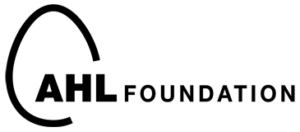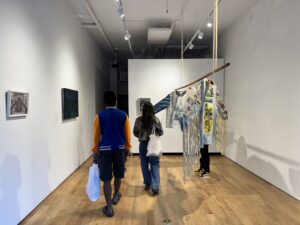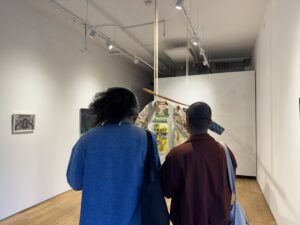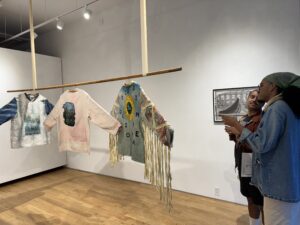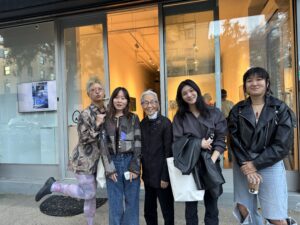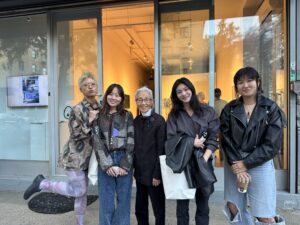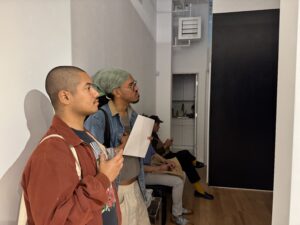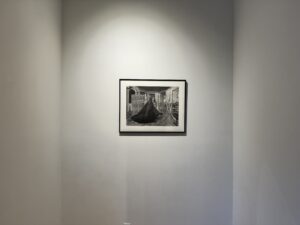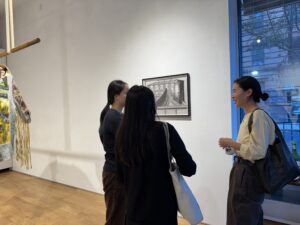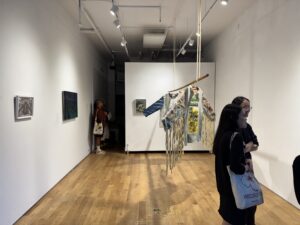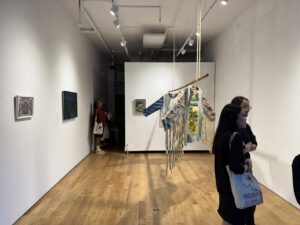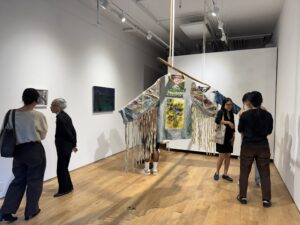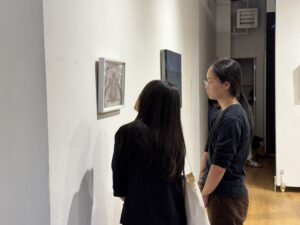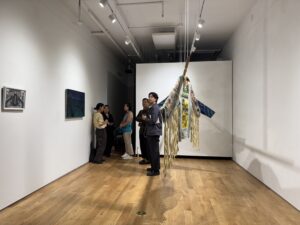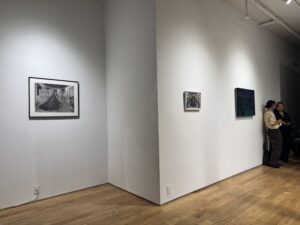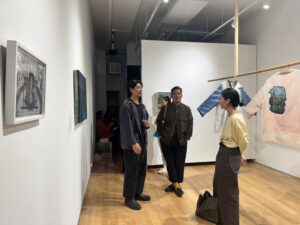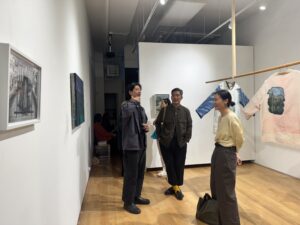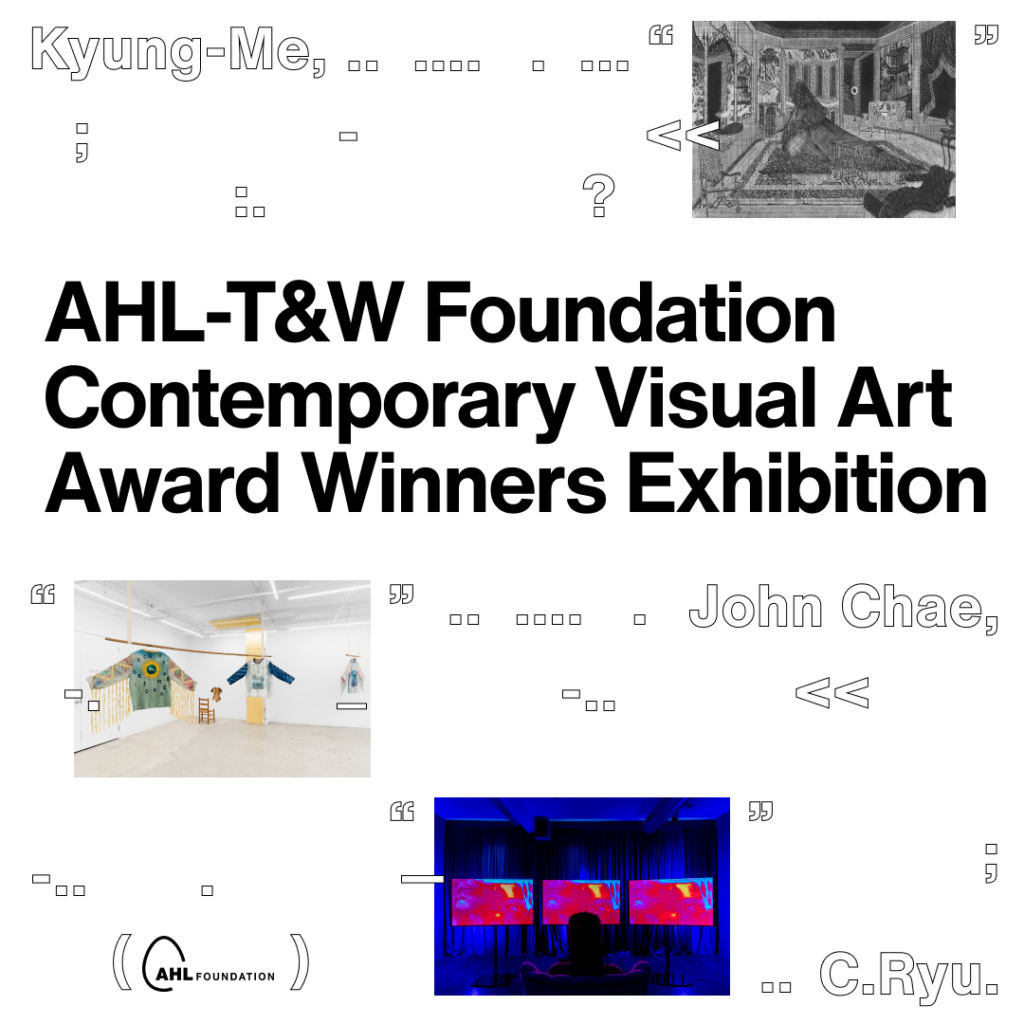
- Exhibition Dates: November 1, 2024 (Fri) – December 6, 2024 (Fri)
- Gallery Hours: Wed-Sat, 12 PM – 6 PM
- Location: AHL Foundation Gallery (2605 Frederick Douglass Blvd. #C1, New York, NY 10030)
- Curator: Ian Wallace
- Participating Artists: Kyung-Me, John Hee Taek Chae, C. Ryu
- Opening Reception: November 1, 2024 (Fri) 5 PM – 7 PM
Curatorial Essay by Ian Wallace
The three selected finalists for this year’s AHL T&W prize each demonstrate, in unique ways, how obfuscation can be used as an artistic tool to counterintuitively reveal something about the nature of identity and its relationship to the real. They each prompt us to think of obscurity not as we habitually understand it—as the making-unclear of something that should otherwise be legible or sensible—but instead as a productive mode of creativity; a means to forge new, oblique approaches to making meaning. In a moment when mass cultural production tends to lean heavily toward the diaristic and self-revealing—when everything is so overly expository—Kyung-Me, John Chae, and C. Ryu each create work that resonates for a smart and refreshing willingness to not simply “reveal”, but to lean into unknowability by devising visual and conceptual languages of mis-recognition. At the same time, Kyung-Me, John Chae, and C. Ryu each engage in rich and challenging ways with art’s history, particularly with the limits of how an image can be used to create meaning.
Kyung-Me creates meticulously rendered ink and charcoal drawings depicting strange and often dreamlike architectural interiors. These compositions are double-edged, verging between trapping and entrapment. Kyung-Me’s figures are as subject to the alienating procedures of symbolization as the architectural spaces they inhabit. The Mother (2022), for example, features a dead-centered figure, seen from behind, who stands before a mirrored dresser that creates a mise-en-abyme of her own image. These kinds of doublings, reflections, and echos recur throughout Kyung-Me’s drawings; the figures and objects that populate her surreal spaces become intertwined with the symbolic language of perspective and the compositional grids they inhabit or interrupt. Rather than placing an object or figure directly over her compositions’ central vanishing point, as Renaissance painters often did—frequently as a way to guide the viewer’s eye to said figure and to thereby emphasize their narrative importance—Kyung-Me allows her voids to be voids, and in some cases, figures are entirely absent, as in the straight-on view into a receding abyss of a hallway in the drawings titled The Corridor (2023 and 2024). Her objects seem not so much to fill the space they inhabit as to float on the surface of her carefully constructed spatial grids, reinforcing her compositions’ constructed nature.
If Kyung-Me’s work hinges on the relationship between the figurative and the symbolic, feeding both through a spatial grid of estrangement, John Chae’s work instead plays with cliché.
Chae’s work is informed by the idea of “autochthonophilia,” which describes the settler colonist’s desire for and identification with the indigenous culture of an occupied land. For Chae, this procedure of corrupted nostalgia becomes a rich ground from which to explore his own identity as a second-generation Korean American. His oil-on-linen Western Paintings (2022), for example, hint at the aesthetics of kitschy thrift store painting, reprising imagery imbued with a romanticized connection to the American West: cowboys, horses, quilts, desert landscapes, and so on. The series is simultaneously intertwined with Chae’s interest in the work of the Italian Jesuit missionary Guiseppe Castiglione, who served as an imperial court painter for three successive emperors of the Qing Dynasty in eighteenth century China, and whose paintings were intended to both suit the stylistic tastes of the Qing court and to convert the same audience to the artist’s own Catholic faith. Some of Chae’s Western Paintings are copies of Castiglione’s works. Chae’s paintings stylistically suggest the layers of history and reference they have been filtered through; they are rendered in diaphanous layers, as if sun-bleached.
Of these three artists, C. Ryu perhaps produces the most counterintuitively “obscured” work, created using an Axis Q-19 thermal surveillance camera. As a medium for visualizing the self, body temperature is somewhat contradictory: every body rests at 98.6 degrees, which means, in theory, that every person’s body appears the same way to a thermal camera. Is your body heat part of you, or just a trace you leave behind? To what uses might its index of bodily presence be put? For Ryu, this becomes a question of the body’s legibility as a carrier of cultural and familial descent. lost | born in translation (2022–23) is a 25-minute, three-channel video divided into three parts, each titled with a purposeful mis-translation from a Korean phrase and each accompanied by the voice of a different narrator. The video installation’s imagery emphasizes aspects of the artist’s body that are considered taboo or shameful in contemporary Korean culture: female narcissism, menstruation, and nudity. The film’s three-part narration draws parallel between these taboo images of the body and voices that have been silenced in the national and migrational history of Korea. Yoo does not romanticize these stories and histories, but critiques the nostalgia attached to them by confronting them with her own body’s thermal presence.
Kyung-Me and Chae both work in media that could be described as largely “traditional,” but inflected with “perspectives” (using the term figuratively in regard to Chae and literally in regard to Kyung-Me) that upend the expectations of those media. Kyung-Me uses linear perspective not to depict real places with naturalistic accuracy, but instead to enhance the strangeness of her compositions; fidelity to the proportions of actual space, in other words, becomes a false signal of the replication of the real, goading the viewer to mentally enter her complex mind-palaces. Though carried out via familiar media, Chae’s work in painting and dyed textiles is produced in highly unconventional, experimental ways; for example, the installation A Dark and Bloody Ground (2023), for which Chae turned AI generated landscapes into cyanotypes that were then printed on patchwork canvases. Chae short-circuits the route from image to meaning, strategically deploying cliché and remixing traditional media techniques to invest his work with layers of complex historical and cultural meaning. It is arguably presence, meanwhile, that Ryu’s work most forcefully insists on; though that presence arrives via layers of abstraction or mediation that remind us that representation is always highly contingent and imperfect.
Through distinct methods and media, Kyung-Me, John Chae, and C.Ryu each recognize that “recognition” is itself a fraught thing. What do our internal worlds look like? What happens when they are confronted with, and attempt to coalesce with, an exterior reality? How do we grapple with being perceived when perception is always colored by cultural expectations and beliefs? Through these artists’ works, we are able to begin to see the ways that these questions intersect with the experiences of immigration, cultural assimilation, being in diaspora, surveillance, and alienation; some of the most pressing social issues of our time.
Ian Wallace
Associate Curator, Amant
Ian received his PhD in Art History from the CUNY Graduate Center in 2021 with a dissertation focused on the work of the artist Charlotte Posenenske. His research focuses on the concept of value in modern and contemporary art, art’s capacity to address pressing social issues, and the “lives” of conceptual practices in institutional collections. He has previously worked at Fondazione Prada, the Museum of Modern Art, Dia Art Foundation, and the New Museum and has additionally contributed to exhibitions at La Fondazione Emilio e Annabianca Vedova, Venice; the International Studio and Curatorial Program, Brooklyn; the Museum of Jurassic Technology, Los Angeles; and Städtische Galerie im Lenbachhaus und Kunstbau, Munich. In 2022, he was Assistant to the Curator of the 59th Venice Biennale, The Milk of Dreams. He is currently Associate Curator at Amant, Brooklyn.
About the Artists
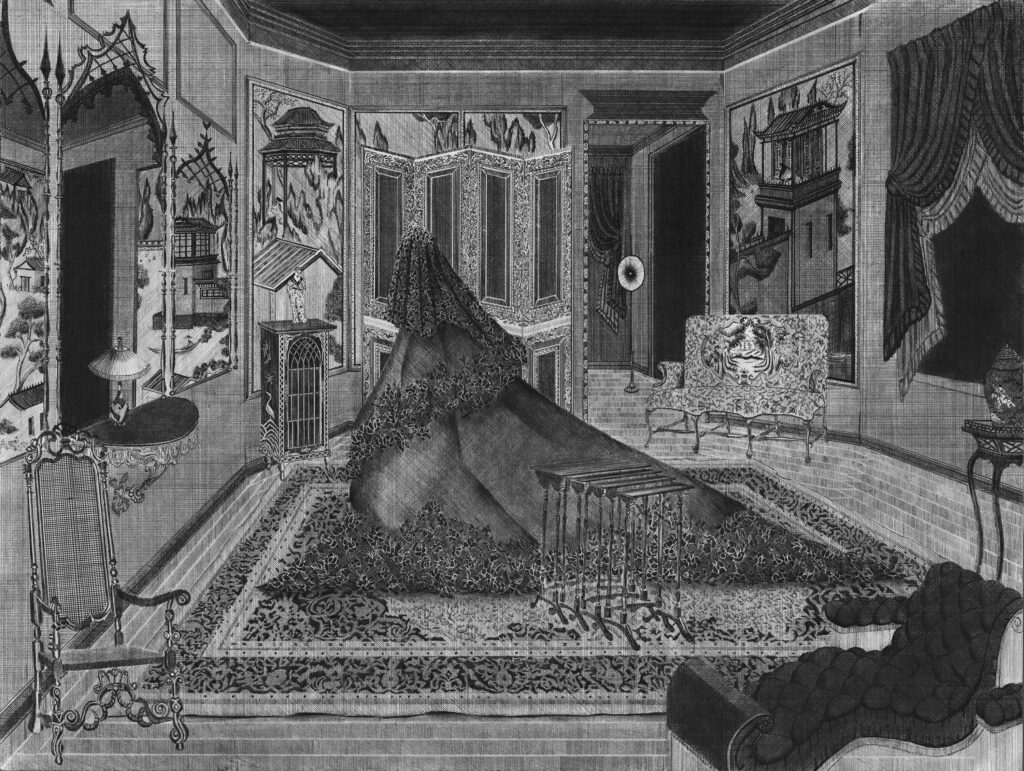
Kyung-Me
Half-Mourning
Iink and charcoal on paper, 18” x 24”
2018
Kyung-Me (Gold Award)’s work explores potential architectures of the subconscious and how images, objects, and memory are intertwined to conjure complex and spiritual spaces. Working predominantly in ink and charcoal, she creates drawings of labyrinthian spaces. In these interior worlds, she explores the seductive and sinister nature of entrapment structures. She is interested in the invisible architecture of entrapment — from the familial and societal to the psychological and spiritual. Kyung-Me (b. 1991, lives and works in New York, NY) graduated from the Yale School of Art with an MFA in 2018. Her work has been collected by the Whitney Museum of Art, Baltimore Museum of Art, and Magasin III. Recent shows include: “Sister”, Bureau, New York, NY (2022); “Introverse: Allegory Today”, 80WSE, New York, NY (2022); “Liminal Spaces”, Kraupa-Tuskany Zeidler, Berlin, 2019; “Coniunctio” with Harry Gould Harvey IV, Bureau, New York, NY (2019); “Poor Thing” with Sydney Shen, Hotel Art Pavilion, Brooklyn (2018); “Copy Kitty”, Selena Gallery, Brooklyn (2017); and “Bad Korean”, 17 Essex Gallery, New York, (2016). Kyung-Me is represented by Bureau (New York) and Kiang Malingue (Hong Kong). She is the author of two books, Copy Kitty, published by 2dCloud (2020) and Bad Korean, published by Spaceface Books (2016). She also teaches at Rhode Island School of Design, New York University, and the Pacific Northwest College of the Arts.
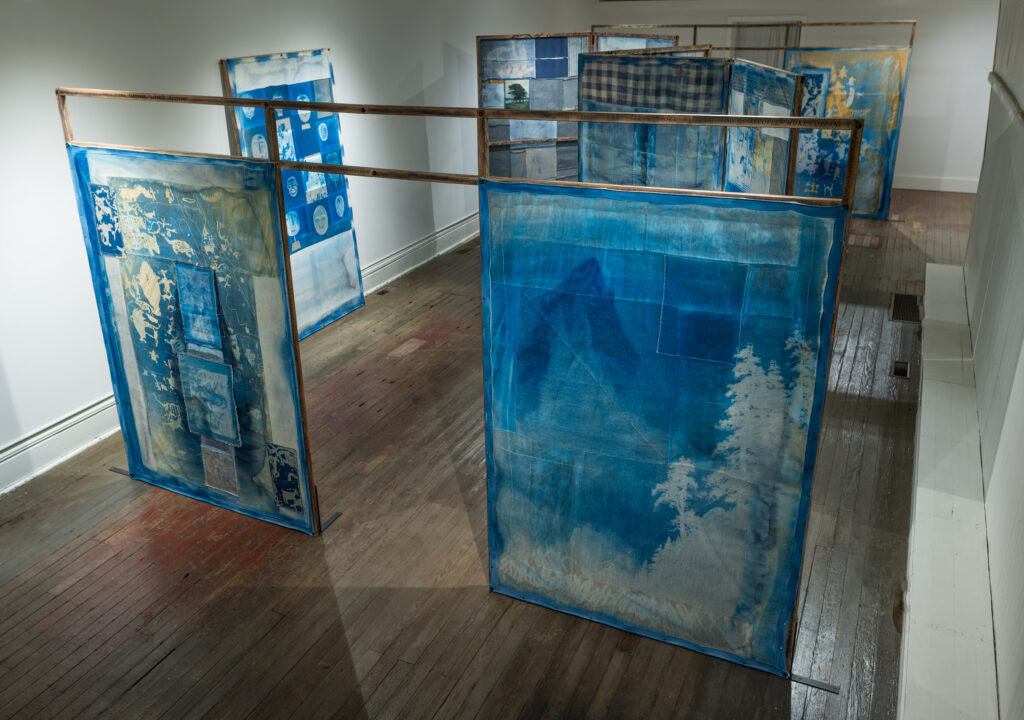
John Chae
A Dark and Bloody Ground
Wood, oil on linen, cyanotype, fabric dye on linen, silk, cotton, and polyester, Installation
2023
John Hee Taek Chae (Silver Award) is an artist and educator whose work is interested in the hybridization and mutation of visual culture primarily through the practice of painting. John received his BFA from the Maryland Institute College of Art in 2010 and his MFA in Painting and Printmaking from Virginia Commonwealth University in 2020. His previous solo exhibitions include A Dark and Bloody Ground at Institute 193 (Lexington, KY), Shed Your Eyes at MARCH (New York, NY), Western Paintings at D. D. D. D. (New York, NY), and Make. Believe. at MOCA Jacksonville (Jacksonville, FL), among others, and he was awarded the MacDowell Fellowship in 2021 and was a Yaddo Fellow in 2022. He was the Cynthia Woods Mitchell Scholar in Residence at the University of Houston in 2023 and is now Assistant Professor in the School of Art and Design at Alfred University.
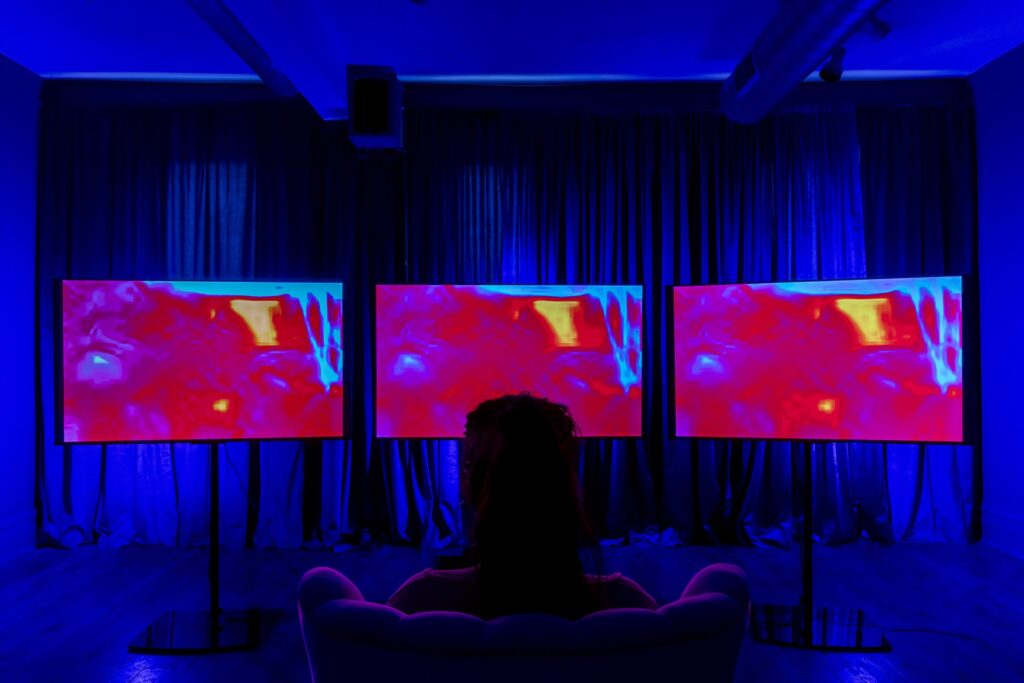
C.Ryu
Alice & Alice: in Free Fall
New Media 3 channel installation in fabricated blue room
2023-2024
C. Ryu (Bronze Award) is an interdisciplinary artist using translation as a tool to map forgotten histories – to reveal psychological shadows haunting | hunting the diaspora – and performs contemporary translations of rituals for the living. Ryu was born and raised in the United States to Korean immigrants. Ryu moved a total of 8 times over the first 18 years of life. Infatuated with moving, memory & movement, and migration, Ryu’s practice spans through mediums of performance, social practice, intimate gatherings, and video installations often using techniques conflating documentary and science fiction to parse through the warped nature of emotional time in migration storytelling. Tracing the edges of the hidden and silenced perspectives of the past to inform the personal and political of the present, C. visualizes narratives utilizing multiple voices in tension with each other to highlight the complicated structures of empire and power while unraveling imperial illusions through geopolitical poetry. C. Ryu is a co-founder and co-leader of Hwa Records, JADED (named 2022 People of the Year by the Pittsburgh City Paper), and Han Diaspora Group. Ryu has performed, exhibited, and culturally produced at Carnegie Museum of Art; Institute of Contemporary Art, San Francisco; McDonough Museum of Art; University of Southern California; LA Art Show; Kelly Strayhorn Theater; and more.
About the AHL-T&W Foundation Contemporary Visual Art Awards
Established in 2003, the Contemporary Visual Art Awards is an annual competition open to all contemporary artists of Korean descent active in the United States and is part of AHL Foundation’s core program. The awards recognize the work of exemplary young emerging contemporary artists of Korean descent and provide them with a monetary prize and the opportunity to have their work presented at a group exhibition in New York. Since 2016, the award has been generously supported by the T&W Foundation, established by Wonsook Kim and Thomas Park Clement
For media inquiries, please contact:
info@ahlfoundation.org
